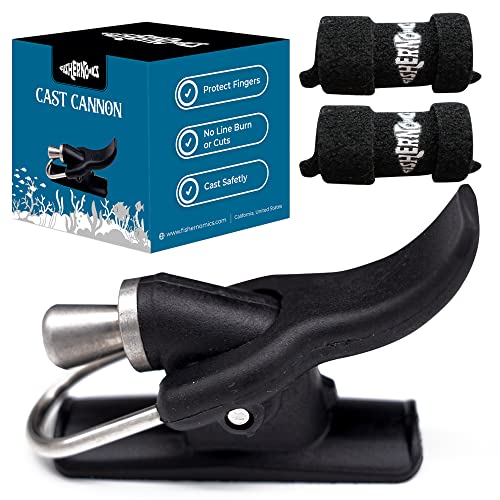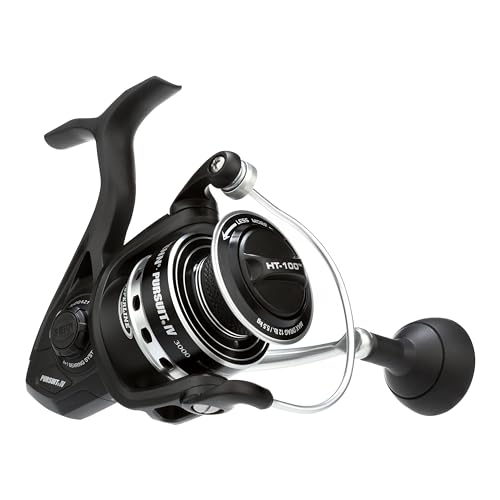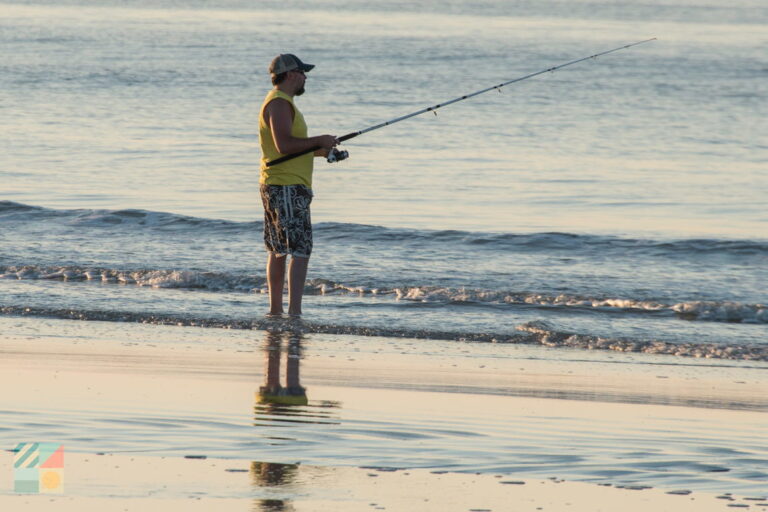For surf fishing, use a line that is strong, durable, and designed for saltwater conditions. A good choice is braided line with a breaking strength of 20 to 30 pounds.
Surf fishing requires the right equipment to ensure success, and one crucial element is the fishing line. When selecting a line for surf fishing, it’s essential to choose one that can withstand the harsh conditions of saltwater and is strong enough to handle the weight and power of larger fish.
A braided line with a breaking strength of 20 to 30 pounds is an excellent option as it provides both strength and durability. This type of line is less likely to snap under pressure and has excellent sensitivity, allowing you to feel even the slightest nibbles. So, make sure to equip yourself with the right line for surf fishing to improve your chances of landing a prized catch.

Credit: www.cntraveller.com
Understanding The Importance Of The Right Line
Choosing The Line: The Key To Successful Surf Fishing
When it comes to surf fishing, choosing the right line is crucial for a successful fishing experience. The line not only connects you to your catch but also plays a vital role in casting distance, strength, and overall fishing performance.
Here are the key points to consider when selecting the perfect fishing line for surf fishing:
- Durability: Opt for a line that can withstand the harsh conditions of the surf, such as abrasive sand, rocks, and strong currents. Look for lines that are specifically designed to be abrasion-resistant, ensuring they hold up well against these rough conditions.
- Strength and weight: Surf fishing often requires casting long distances, so it’s important to choose a line with the appropriate strength and weight. Consider the size and weight of the target species you’re aiming for, as well as the type of bait you’ll be using. Heavier lines are ideal for targeting larger fish, while lighter lines are suitable for smaller catches.
- Visibility: The visibility of the line can make a significant difference in your fishing success. In clear water conditions, a low-visibility line is recommended to avoid spooking the fish. On the other hand, in murky or turbid waters, a hi-vis line can help you monitor your line movement and detect bites more easily.
- Stretch and sensitivity: The amount of stretch and sensitivity your line has can greatly impact your fishing experience. A line with higher sensitivity allows you to detect subtle bites and movements, while a line with more stretch can provide a cushion when fighting against strong fish. Finding the right balance between stretch and sensitivity is crucial to maximize your chances of landing your catch.
Factors To Consider: Matching Line To Fishing Conditions
To maximize your chances of surf fishing success, it’s essential to match your line to the fishing conditions you’ll encounter. Here are some factors to consider when selecting the appropriate line for specific fishing conditions:
- Water clarity: In clear water, opt for low-visibility lines to avoid spooking the fish. For murky or turbid water, choose a hi-vis line to help monitor line movement and detect bites more easily.
- Tide and current strength: Consider the strength of the tide and currents you’ll be fishing in. In areas with strong currents, a heavier line is recommended to ensure better control and prevent line breakage.
- Weather conditions: Take into account the weather conditions you’ll be fishing in. Windy conditions can affect casting accuracy and distance, so using a thicker line or adding a shock leader can help combat these challenges.
- Target species and bait: The size and weight of the target species, as well as the type of bait you’ll be using, should also influence your line choice. Heavier lines are ideal for larger fish, while lighter lines work well for smaller catches.
Testing The Waters: Trying Out Different Lines For Ultimate Performance
Finding the perfect line for surf fishing often requires some experimentation. Here’s why trying out different lines can lead to improved fishing performance:
- Casting distance and accuracy: Different lines have varying thickness and flexibility, which can affect casting distance and accuracy. By testing out various lines, you can find the one that allows you to cast further and with greater precision.
- Sensitivity and bite detection: Each fishing line offers a unique level of sensitivity. Some lines are highly sensitive, enabling you to detect even the slightest bites, while others may be less sensitive. Trying out different lines can help you determine which one allows you to feel the fish better and increase your bite detection rate.
- Strength and resilience: Surf fishing requires lines that can handle the challenges posed by the surf, including strong currents, sandy bottoms, and sharp rocks. By experimenting with different lines, you can assess their strength and resilience in these conditions, and choose the one that holds up best.
- Personal preference: Every angler has different preferences when it comes to fishing lines. Some prefer lines with more stretch, while others favor those with higher sensitivity. By testing out various lines, you can identify the one that aligns with your fishing style and personal preferences.
Choosing the right line is essential for successful surf fishing. Consider factors such as durability, strength, visibility, and stretch when selecting a line. Additionally, match your line to the specific fishing conditions at hand, including water clarity, tide and current strength, weather conditions, target species, and bait.
Finally, don’t be afraid to test different lines to find the one that offers optimal casting, sensitivity, strength, and personal preference. Happy surf fishing!
Exploring The Different Types Of Fishing Lines
Monofilament Line: Versatile And Reliable For Surf Fishing
Monofilament line, often referred to as mono, is a popular choice among surf fishermen due to its versatility and reliability. Here are the key points to consider when using monofilament lines for surf fishing:
- Superior knot strength: Monofilament lines have excellent knot strength, ensuring your knots hold firm when battling the surf and powerful fish.
- Stretch and shock absorption: Mono lines have a certain level of elasticity, allowing them to stretch under pressure, which can be beneficial when fighting against strong, energetic fish in the surf zone.
- Abrasion resistance: Monofilament lines are known for their resistance to abrasion, making them ideal for surf fishing where rough rocks and sharp structures are common.
- Visibility: While mono lines are not entirely invisible underwater, they provide decent visibility, especially in clear or slightly murky water conditions.
- Cost-effective: Monofilament lines are generally more affordable than other types of lines, making them an economical choice for surf anglers.
Braided Line: Enhancing Strength And Sensitivity In The Surf
Braided lines, also known as superlines, offer enhanced strength and sensitivity, making them a popular choice for surf fishing. Here’s what you need to know about using braided lines in the surf:
- Incredible strength-to-diameter ratio: Braided lines are much stronger compared to their diameter, allowing you to use thinner lines while still maintaining excellent strength. This is especially advantageous when casting long distances in the surf.
- Improved sensitivity: The lack of stretch in braided lines results in increased sensitivity, enabling you to detect even the slightest nibbles and strikes, ensuring you don’t miss any potential catches.
- Enhanced casting distance: The thin diameter and low friction of braided lines contribute to increased casting distance, allowing you to reach those elusive fish in the deeper parts of the surf.
- Minimal line memory: Unlike monofilament lines, braided lines have minimal line memory, meaning they won’t retain the coils and twists from being spooled. This reduces the chances of backlash and tangling during casting.
- Increased durability: Braided lines are highly resistant to abrasion, making them ideal for surf fishing where encounters with rough structures and sharp rocks are common.
Fluorocarbon Line: Stealthy Approach For Wary Fish
Fluorocarbon lines are valued for their invisibility in the water and ability to deceive wary fish. Here’s why fluorocarbon lines are an excellent choice for surf fishing:
- Near-invisibility underwater: Fluorocarbon lines possess remarkable refractive properties that make them nearly invisible in water. This can be crucial when targeting selective and easily spooked fish in the surf zone.
- High sensitivity: Fluorocarbon lines offer excellent sensitivity, allowing you to detect even the slightest bites and nibbles from skittish fish.
- Strong and abrasion-resistant: Fluorocarbon lines are known for their strength and resistance to abrasion, ensuring they can withstand the rugged conditions of surf fishing.
- Sink rate: Fluorocarbon lines have a higher density than water, causing them to sink faster. This can be advantageous when using certain fishing techniques, such as bottom fishing or targeting fish at specific depths in the surf.
So there you have it – the different types of fishing lines for surf fishing. Each line type has its own unique benefits and considerations, so be sure to choose the one that best suits your fishing style and target species.
Happy surf fishing!
Determining The Ideal Line Strength And Diameter
Line Strength: Matching It With Target Fish Species
Choosing the right line strength is crucial when it comes to surf fishing. Different fish species have different levels of strength and aggression, so it’s important to match your line strength accordingly. Here are a few key points to consider:
- Determine the target fish species: Before selecting the line strength, identify the specific fish species you’re targeting. Research their average size, fighting behavior, and strength. This information will help you gauge the appropriate line strength needed to handle them effectively.
- Consider the weight rating: Fishing lines come with weight ratings, which indicate their breaking strength. For smaller fish species, a line strength between 6 to 10 pounds may be sufficient. However, if you’re targeting larger and more powerful fish, such as striped bass or redfish, you’ll need a line with a strength ranging from 20 to 30 pounds.
- Balance rod and reel compatibility: Your line strength should align with the capacity and capabilities of your fishing rod and reel. Ensure that they are designed to handle the chosen line strength effectively. A mismatch between the line and tackle can lead to equipment failure or a compromised fishing experience.
- Consider environmental factors: Don’t forget to consider external factors such as rough surf, strong currents, and underwater obstacles. These elements can put additional strain on your line. To handle such conditions, it’s wise to opt for a slightly higher line strength to ensure that your line can withstand the challenges of the environment.
- Adjust based on personal preference: Some anglers prefer using slightly heavier lines to provide extra security and confidence. It ultimately depends on your personal fishing style and comfort level. Experimenting with different line strengths can help you find the perfect balance between strength and flexibility.
Impact Of Line Diameter: Balancing Strength And Visibility
Besides line strength, the diameter of your fishing line is another critical factor to consider. The line’s diameter affects both its strength and visibility. Let’s delve into the important points:
- Strength versus visibility: Thicker fishing lines generally have greater strength. However, they may also be more visible in the water, potentially spooking fish. Thinner lines, on the other hand, provide better invisibility but sacrifice some strength. Finding the right balance between strength and visibility is essential.
- Angler’s skill level: Beginners may benefit from using slightly thicker lines, as they offer increased durability and ease of handling. Thicker lines are less prone to tangling and offer more forgiving knots. As you gain experience and finesse in your technique, you can gradually switch to thinner lines to enhance stealthiness.
- Fish behavior and water clarity: The behavior of your target fish species and the water clarity of your fishing spot should influence your line diameter choice. In clear water conditions, where fish are more cautious, thinner lines with low visibility are recommended. In murkier waters or when targeting aggressive fish, slightly thicker lines may be more suitable.
- Casting distance and sensitivity: Thinner lines have a smaller diameter, reducing air resistance and enabling longer casts. If distance is crucial in your surf fishing, thinner lines will help maximize your casting range. Conversely, thicker lines provide improved sensitivity, allowing you to detect subtle bites and movements more easily.
- Consider potential line wear: Surf fishing can expose your lines to abrasive elements such as sand, rocks, and debris. Thinner lines are more prone to wear and can be easily damaged. Thicker lines offer increased durability and can withstand harsh conditions better.
Remember, when considering line strength and diameter, personal preferences and fishing conditions play a significant role. Always test and adjust accordingly until you find the right combination that suits your target fish species and enhances your overall fishing experience. Happy fishing!
Evaluating The Line Performance In Different Surf Fishing Scenarios
Casting Distance: Maximizing Your Reach In The Surf
- When surf fishing, having the ability to cast your line as far as possible is crucial. It allows you to reach deeper waters where fish are more likely to be feeding. Here are some key points to consider for maximizing your casting distance:
- Choose a line with a low memory, such as a braided line, as it will allow for smoother and longer casts.
- Opt for a thinner line diameter, which reduces friction and drag during casting.
- Look for lines with a high breaking strength, ensuring they can handle the stress of longer casts and potential heavy fish.
- Practice your casting technique, focusing on smooth and controlled motions to optimize your casting distance.
Line Visibility: Striking A Balance Between Stealth And Control
- The visibility of your fishing line can have a significant impact on your success in surf fishing. It’s important to find a balance between line visibility and control. Consider the following factors:
- Choose a line color that blends well with the water and the surrounding environment. This helps to minimize the chances of fish being spooked by the sight of your line.
- Fluorocarbon lines are known for their low visibility underwater, making them a popular choice for surf fishing. They can give you an advantage in clear water conditions.
- However, keep in mind that fluorocarbon lines tend to have less strength and flexibility compared to other types. Consider the trade-offs and the specific conditions you’ll be fishing in.
Knot strength and abrasion resistance: handling the challenges of surf fishing environment
- Surf fishing can be a harsh environment for your fishing line, with constant exposure to sand, rocks, and saltwater. Here’s what you need to know about knot strength and abrasion resistance:
- Look for lines that have high knot strength, as this will prevent your knots from slipping or breaking under tension. This is especially important when battling bigger and stronger fish.
- Consider using shock leaders – thicker, more abrasion-resistant lines connected to your mainline. Shock leaders help absorb the impact of casting heavy weights, reducing the risk of your mainline breaking.
- Pay attention to the line’s abrasion resistance rating. Lines with a higher abrasion resistance are better at withstanding the wear and tear of dragging against rough surfaces.
- Regularly inspect your line for signs of damage or wear, such as frays or nicks. Replace your line when necessary to ensure optimal performance and avoid any unexpected line breakages.
Remember that each surf fishing scenario comes with its unique challenges and requirements. Take the time to evaluate your fishing conditions and select a line that addresses your specific needs for casting distance, line visibility, knot strength, and abrasion resistance.
Armed with the right line, you’ll be ready to tackle the surf and increase your chances of landing that trophy catch.
Tips And Techniques For Choosing The Right Line
Consult Fellow Anglers: Learn From Their Experiences And Recommendations
When it comes to surf fishing, seeking advice from experienced anglers can be incredibly valuable. Fellow anglers can provide insights and recommendations based on their firsthand knowledge and expertise. Here are key points to consider when consulting your fishing peers:
- Join online fishing communities and forums to connect with fellow anglers who have experience in surf fishing. Engage in discussions and ask for recommendations on the best line for this type of fishing.
- Attend local fishing events and gatherings to meet experienced surf fishermen. Strike up conversations and ask about their preferred lines, as well as any tips or tricks they have discovered.
- Seek out local tackle shops and talk to the staff. They often have vast knowledge about the fishing conditions in the area and can offer recommendations based on their observations and customer feedback.
Considering the experiences and recommendations of fellow anglers can help you narrow down your options and make an informed decision when choosing the right line for surf fishing.
Consider local conditions: tailoring your line choice to the specific surf environment
The choice of line is highly dependent on the specific surf conditions you will be fishing in. Different factors, such as water clarity, wave size, and bottom structure, can greatly impact your line’s performance. Here are key points to consider when selecting the right line based on local conditions:
- Water clarity: In clear or lightly stained waters, a more translucent line can be advantageous as it is less likely to spook fish. In murkier or heavily stained waters, a high-visibility line can help you keep track of your line and detect subtle bites.
- Wave size and power: If you anticipate fishing in rough surf or facing larger waves, opt for a stronger line with higher tensile strength to withstand the force and prevent break-offs.
- Bottom structure: Take into account the type of bottom you will be fishing over. For sandy bottoms, a line with higher abrasion resistance can prevent it from getting damaged by rough particles. If there are rocks or other abrasive surfaces, consider using a tougher and more durable line.
By tailoring your line choice to the local surf conditions, you can enhance your chances of success and maximize your fishing experience.
Testing, testing, testing: experimentation as the ultimate path to finding the perfect line
When it comes to finding the perfect line for surf fishing, experimentation is key. Every angler has their own preferences and fishing style, making it crucial to try out different lines to determine which one suits you best. Here are key points to keep in mind while testing various lines:
- Start with reputable and trusted brands: Begin your experimentation journey by trying out lines from well-known brands that have a good reputation among surf anglers. These lines are often tried and tested, which increases the likelihood of finding a suitable match.
- Vary line types: Experiment with different types of lines, such as monofilament, fluorocarbon, and braided lines. Each type has its advantages and disadvantages, so testing them in different surf fishing scenarios can help you understand their performance better.
- Test different line weights and diameters: Varying the weight and diameter of the line can have a significant impact on your casting distance and ability to handle different-sized fish. Try lines with different weights and diameters to find the right balance for your fishing style.
- Pay attention to sensitivity and stretch: The sensitivity and stretch of a line can affect your ability to detect bites and the overall hook-setting power. Experiment with lines that offer different levels of sensitivity and stretch to find what works best for you.
Remember, finding the perfect line can take time and patience. By experimenting with various options and paying attention to your individual preferences, you’ll be one step closer to discovering the ideal line for your surf fishing adventures.
Conclusion
To wrap up, selecting the right line for surf fishing is essential for a successful fishing experience. By understanding the different types of fishing lines, their features, and their suitability for various situations, you can optimize your chances of catching your desired fish.
Monofilament lines are versatile and cost-effective, making them a popular choice for surf fishing beginners. Fluorocarbon lines offer excellent sensitivity and invisibility, making them ideal for targeting wary fish in clear waters. On the other hand, braided lines provide exceptional strength and durability, perfect for handling heavy lures and battling strong fish.
Each line has its own strengths and weaknesses, so it’s crucial to consider the fishing conditions, target species, and personal preferences when choosing the right line. Remember to regularly inspect and maintain your line to ensure optimal performance. So, arm yourself with the knowledge gained from this article, choose your line wisely, and get ready for a rewarding surf fishing experience!





